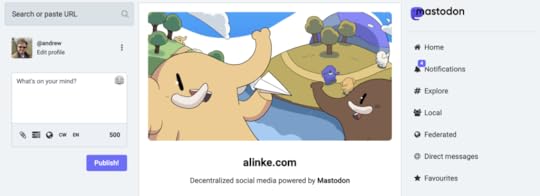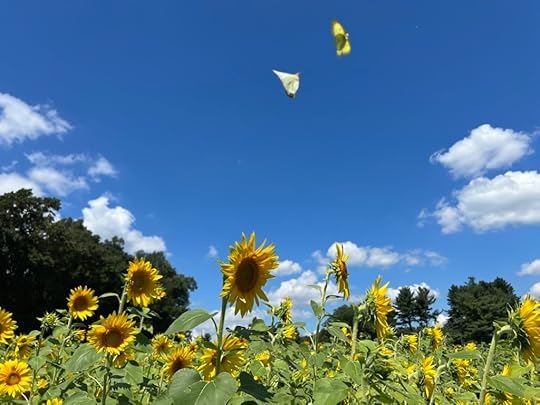Otto Linke's Blog
January 10, 2023
Going Interactive
It’s thirty years ago.
I’m standing in the hallway of our apartment in Cape May and asking my dad how to program a video game. I don’t know a lot about video games, but I know that my dad works with computers and I have a notebook full of sketches showing the levels that an intrepid spaceman needs to cross to reach his home planet.
Dad smiles, but shakes his head and says that he doesn’t know how to program games, but it’s a fun idea.
I’ve wanted to create interactive stories for a long time, but I didn’t quite know how. I spent hours teaching myself QBASIC so I could create simple combinations of text and line art which would take players on an adventure through a cave or a castle. These adventures were often brief because I was hand-coding everything based on what I could glean from a Visual Basic programming guide and the built in help files on QBASIC for DOS 6.22. (That, and I now am pretty darn sure that I was dealing with unmedicated ADHD and there’s only so much that hyperfocus can do to counteract attention deficit).
When I eventually wrapped my brain around writing complete stories, I started playing with the idea of creating a more stylish and subtle version of those old text adventure games. I quickly got lost in the weeds of being a thoroughly inadequate iOS developer, ignored Twine and HTML, gave up trying to make a narrative game that wouldn’t meet my standards, and focused on just writing novels.
But I never quite gave up on the idea of interactive fiction. I like to think that stepping back and focusing on traditional narrative was part of the process of growing into a better storyteller.
And so I wrote nine novels (still editing the last one) and played a lot of role playing game, both tabletop and computer.
Now I am back at it, trying to tell stories in a more interactive way.
The story is still a work in progress, but as an interactive method of writing a story, this has been a lot of fun. I’ve struggled to keep to writing every day, but the fact that I’m back to making an effort to produce new fiction every day feels fantastic.
Most days I post about a page of new fiction and a poll with two-four options for what might happen next. After the poll has completed, I continue the story for another page or so.
And when the story is done… then… then I have plans, which I will talk more about soon.
November 27, 2022
Joining the Fediverse
I’ve been playing around with Twitter for years and have long felt that I would have been deeply into the site if I wasn’t a public school teacher for most of the site’s existence. With the unmitigated disaster of Elon Musk buying Twitter and pouring radioactive gasoline into the Dumpster fire, I decided to join many other people and take a deep look at Mastodon and the Fediverse.
And I’m really enjoying it.
After exploring Mastodon.Social for a couple weeks, I decided that not only do I like this network, but I really want to run my own instance. I want to control my own data and lock down my identity on the internet.
And so, over the course of two weekends and some late night poking about during Thanksgiving Break, I managed to get Mastodon running on an old Intel MacMini in the basement.

Instance: https://alinke.com
My Identity: @andrew@alinke.com
I still need to do a few things to make my Mastodon instance more stable, but it’s completely functional for me as a personal server.
Copy backup files OFF the system every day.The server DOES NOT send emails.Hashtag search is buggy, but I’m starting to think this is more a misunderstanding of how search works on the Fediverse than a problem with my install.Have not installed Elastic Search yet. Not sure if I will.Want to make my website pull posts in and create a single weekly summary blog.Need to make the server automatically relaunch on reboot. See General Notes for the commands.General NotesAfter a lot of false starts and poking around, I managed to get my server online by following a combination of guides.
The most important one was How To Forge’s Guide to Install Mastodon. The core of that guide seems to be solid and I had very few problems that couldn’t be traced back to my own inexperience with Linux version control and managing databases via terminal commands. It is impossible to install Mastodon going purely by the guide, due to version numbers and dependancies changing since publication, but the basic progression is solid.
The instructions for making Nginx properly connect to the Let’s Encrypt Certificate seem to be out of order, probably because the Certbot Nginx plugin repository is deprecated, so I had to install Certbox as a full app rather than an Nginx plugin. I got the workaround by using bits of code from David Field’s Tech Blog guide to installing Pleroma. I couldn’t get Pleroma working, but the Let’s Encrypt portions of the guide are apparently more stable.
After installing everything, I realized that not having an SMTP server running would make it impossible to receive authorization emails from my own instance. Rather than spending hours futzing around with email servers, I just dug into the tootctl CLI to authorize my admin account and a personal account directly, skipping the e-mail confirmation loop.
Very Important NoteFile permissions for the Mastodon Public Folder were wrong after following these guides. I ended up having to chmod 0755 the mastodon/live/public folder to make it readable.
Domain and Port ForwardingThe biggest problem I see is that I’m running this as a home server, so if my IP address changes I’ll have to update the A-Records of my domain to the new IP.
And obviously I had to lock the computer running the instance to an internal IP address and forward SSL and HTTP ports on my home router to it.
Is it Worthwhile?
Personally, I have a lot of fun digging around in the Linux terminal and figuring out how to make arcane software run, so that alone was worthwhile for me. As a piece of technology and social media network, we’ll have to see what becomes of the ActivityPub Fediverse over the next couple years, but I do think there will be a future in decentralized social networking. Will they rival Facebook or a (somehow not afire) Twitter? Probably not… but I love the concept of owning my own identity online so even if I someday return to Twitter or a newly crowned successor, I’ll probably continue to play with Mastodon for a long while.
November 7, 2022
Fade to Gray

I’ve been a photographer since I was about eleven years old.
I still remember crawling through the mud in our backyard in Maine, carving out rivers in the dirt and poking small fragments of plants into the earth until I had created exactly the scene I wanted to capture on my mother’s 35mm Olympus SLR. This was all done in an effort to recreate the sense of wonder that I experienced seeing the towering jungles of Jurassic Park.

It wasn’t long after that that I received my first Kodak digital point and shoot camera. It was low resolution, unreasonably difficult to download photos from, and our computer only had a 6gb hard drive and the most basic of photo editing software, but it was a complete thrill to use. I don’t have a lot of pictures from that camera, since it predated our signing up for broadband internet or keeping a backup hard drive attached to the computer by nearly a decade, but I had a lot of fun capturing photos without the need to pay for developing film.

Taking the time to go out and capture photos is, as with all of my myriad hobbies, a challenge. This is especially true of portraits, since I am eternally surrounded by humans who dislike having their photo taken. Fortunately, my family is very patient about me continually lagging behind to take photos while hiking in the mountains of western Maryland. They don’t even complain when I wander off from the pack to lay on the ground and take photos of flowers against the sky.

And so it is with great pride that I offer you all my first photography book, which will hopefully be followed by many more. I’ve been working on the book for a couple months, struggling to balance instruction with inspiration. My experience writing leans heavily towards fiction, instructional material, and the occasional mad rash of poetry, so composing a book that is intended to share my love of photography with others was complicated. The book certainly skews towards educational, but I hope readers will find delight in the several unusual bits of history and science which I try to explain.

Black & White Photography is intended to be a light-weight textbook of sorts. Combining history, science, and art with thoughtfully chosen challenges to help you become a better photographer. Each of the four core chapters closes with five challenges and five topics for contemplation, all linked to the example photos and photographic techniques discussed in the preceding text. I have paired each topic with a selection of my favorite black and white photos, some of which accompany this post.

You can download a free PDF of Black & White Photography here. If you like it, please share this post with everyone you know and toss a like/follow/etc. to my Twitter, Facebook page, and YouTube. I’d also love for you to check out the asynchronous course based on the book for your kids and contact me if you, as an adult, would like to take any photography classes. I admit to feeling awkward offering classes to adults, as I am by no means a professional photographer, but enough friends, family, and clients have enjoyed my photos that I have finally been convinced that I’m a decent photographer.
Cold is the night but
–Jars of Clay
Colder still is the heart made of stone, turned from clay
And if you follow me
You’ll see all the black, all the white fade to gray
Fade to gray

November 6, 2022
Killing Words
NOTE: This is an incomplete short story which I wrote several years ago as an experiment. It’s extremely rough and likely filled with mistakes. I’m sharing it because I plan on taking elements of this story, tweaking them to fit my Covenant universe setting, and then expanding the story into a murder mystery novel. Look for more about that novel in 2023.
The day that Vernon was murdered, we forgot how to see green.
I know that we forgot green because the word still appears in dictionaries and books. I even know that it was often used to describe grass and trees and often counted as the opposite of red in indicators and children’s games. But not a one of us remembers what green looks like. I stand in the conservatory beneath the arching branches of the elder trees, gazing up at the old sun through leaves which tremble in the breeze, and I see the leaves and yet the color of their delicate veins and broad surfaces is indistinguishable to from that of the branches and trunks. It’s not grey. It’s not black and white.
But I simply cannot think of it as green, because that color no longer exists.
Like the numbers between ten and thirteen.
I know that they must have existed once, long ago, in the days before the Revelation, when there was yet a veil between the realms of man and the divine, but for as long as I can remember I have counted seven, eight, nine, ten, ten and one, two sixes, thirteen…
It was on the seventh day of the month between March and May when Detective Kline approached me as I sat at the picnic table beneath the trees that had been green. Since my retirement I have busied myself with attempting to compose poetry about that which we have lost. This is difficult, as the essence of loss is to know that you no longer have something and much of what was lost cannot be recalled, but with great effort I will often succeed in crafting a single evocative stanza in the course of a long morning spent amid the fragrant blooms of the morning glory vines.
Rosemont steps up beside me, her presence announced by the heady scent of coffee and the jangling, irregular step of her braced legs. Her obscura falls across my page, but I don’t look up from scratching out my final, fading memories of how leaves might once have appeared before the world was robbed of their name.
“We need you back,” she says, tossing a folio atop my notebook.
“I’m retired,” I say.
“We lost another one.”
“We lose one every day,” I reply, pushing the file aside and scratching out one of the words in the ten plus oneth line. After a moment’s hesitation I cross out all the words. When I publish the poem I’ll replace this line with ten plus one hyphens, even if it interferes with comprehension. That’s the point.
“It’s getting bad.”
I drop my pencil into the gutter of the book and stand suddenly, taking full advantage of my extra six inches to glare down at Rosemont. As if I need anyone to tell me that it is getting bad. I shove the folio aside, pick up my notebook, and give Rosemont one last withering glare before striding away across the conservatory, the white and grey bone of the path crunching beneath my soles.
“It’s not just a regular murder,” Rosemont shouts after me. “The killer is looking for someone. They’ve already murdered three carriers and there will be more.”
I keep walking. Rosemont grunts and hurries to catch up, her uneven steps crunching arrhythmically on the bone path. Just as I begin to scent her coffee she slaps my shoulder with the folio and snaps, “We need to find this killer before they work out their target.”
“Who’s the target?” I ask. Immediately I regret it. I don’t care who the killer is after. Rather, and worse, I do care and I with I didn’t.
“We don’t know yet, and that’s what’s got me worried.”
I stop walking and turn to glare at Rosemont.
She glowers at me and proffers the folio.
Muttering oaths, I take the folio and flip to the summary report. Three murders, yes. In each case the victim’s throat was slit with an exceptionally sharp blade which was not found at the scene. A clay bead was found lodged in each victim’s neck, having been placed there postmortem.
Rosemont nods when I look up from the report, one eyebrow raised. She knows what caught my eye.
A string of vile expletives pours from my lips and I return to reading.
Flipping to the reports on the beads, my fear is confirmed. The balls measure just under three inches in diameter. Each has been hand crafted from marbled white and black clay and its surface engraved with sigils before being fired unglazed.
“I don’t see anything about the effect of the sigils.”
“We haven’t cracked them, yet,” Rosemont replies. “The best our mancers can work out is that they seem to be related to forgetfulness, but the grammar is all wrong. The magic doesn’t work and the geometry is all wrong.”
“But they have a meaning to the killer.”
“They must.”
“Have there been other killings with these clay spheres?”
“These are the first. I mean, the first since —” She hesitates and I’m not sure whether she’s uncomfortable or simply having trouble remembering. So many people cannot remember once a name has been lost.
“Is this why you want me?”
“This is why the commissioner doesn’t want you. When he can be made to remember you exist he is vehemently opposed to bringing in one of the forgotten to deal with a killer, but…”
“But since he doesn’t even remember me most of the time, you figure it’s safe to bring me in.”
She replies with an awkward shrug.
Around us, the young play in the grass, laughing as they chase one another through the open spaces. How long has it been since I could remember what we once called them? Certainly long enough that most people cannot even remember a time when they were known as anything other than the young.
“The killer is looking for somebody. I’m sure if it. Every one of these murders has been ritualized. The sigils are nonsense, but they clearly indicate that the killer doesn’t just want to kill the people, but the semiote which they carry.”
“The sigil isn’t effective.”
“No, but take a look at page…” she hesitates. Swears and kicks at the bones of the path. Finally she says, “Eight pages after twenty nine. We’ll need to add a blank sheet to the file there if I can’t remember by tomorrow.”
I turn to page thirty seven, the number slipping from my mind as I glance at it, but I am able to bring it back with some effort. The carrier must have died recently. If a child is born soon there may be some chance of the semiote finding a new host, but I don’t have much hope. Rosemont, like many in the division, is more resistant to the vanishing than most people are, so if she is already forgetting about thirty seven then chances are good that your average person under the old sun has already forgotten.
The page features a map of the city, with the times and locations of the murders marked in red. Another list, this in blue, marks the times and locations of births. The homes and workplaces of the victims are marked in… they are marked. All of the births took place far from the murders and none of the killings happened on the same day as a birth. In two of the three killings, the victim lived and worked several miles from where their body was found.
“The killer is trying to eliminate semiotes. I’m sure of it. Why else take the trouble and risk to bring them so far from their homes before killing them?”
“I don’t know if I can be part of this,” I say, closing the folio and pushing it against Rosemont’s chest. “I’ve already lost too much.”
“And we’ll all lose more if you don’t help. If you won’t do it to save our world then do it to get some vengeance.”
“You don’t know that it’s the same killer.”
“We never released the detail about white and black clay to the public.”
“The clay could be a conincidence. The sigils are new.”
“An evolution of the psychosis. Please…” Rosemont grasps the folio and pushes it back towards me, covering her inability to remember my name with a grunt of effort. “Please, just help us catch this killer and I promise you will be taken care of.”
“I have what I need.”
“You’re one of the lost. Do you even have a home anymore?”
“Of course. Nobody knows who I am, but they know my poetry. Besides, one benefit of being forgotten is that nobody bothers to evict you.”
“You can’t be happy like this.”
I sigh and turn away from Rosemont, those who did not survive the Revelation crying out beneath my feet, reminding me with each grinding step that there are fates worse than being forgotten. I pause at the fountain and sit on a curved block of granite, watching as arcs of water chase one another around the statues of fallen Wardens. Young play amid the spray, the smallest of them giggling and chasing the streams as their elders stand above the nozzles, waiting for the spray to slam into the bottoms of their feet, knocking them off balance and spraying water all about.
“This one is bad. I can’t put a finger on it, but I know that the killer is aiming for somebody in particular. My gut tells me that they want to kill a word.”
“Have you found any evidence of divination?” I whisper, my voice barely audible over the rush of water and laughter of young people. “Any sign that they are actively seeing out a particular semiote?”
“No direct evidence, but look at the victims.” She slaps her hand against the folio as she names each of them in turn. “The color of grass and trees. The flavor of bacon. The concept of… of…”
“Mercy,” I whisper.
“I think so, but damn it all I can’t remember. Don’t you see, they are targeting major semiotes in different classifications. We’re not talking about forgetting the name of a historical figure or a cocktail recipe. We’re talking about essential concepts. Things that keep us human.”
The water dances across the plaza. The young people play. I try to remember the color of leaves, but even I am beginning to forget what… what… green… yes, green looks like. Rosemont stands beside me, rigid atop her artificial legs.
“Show me. I’ll do what I can.”
An hour later we stand in the morgue. Vernon’s corpse is laid on the cold steel table beneath an array of lights and imaging devices. Hard to imagine that this chubby man in his late forties carried the essence of green within his soul, but that’s the world we’ve come to live in since the Raveling.
“Show me the semiotica,” I command the mortician’s assistant.
“It’s gone.”
I roll my eyes and shoot Rosemont an exasperated look. “I can go back to writing poetry in the park. I really don’t mind it.”
“Just turn on the augur,” Rosemont snaps.
The assistant grumbles and activates the semiote imager. The room goes dark, then a feeling like a blast of cold air moves through my body and the cluster of lamps above Vernon’s corpse shudders, then pours out a sickly silver light. The light burrows into Vernon’s body, melting away flesh and bones until nothing remains but a ghostly outline atop the examination table.
“I told you, the semiote has been gone for days. There’s no trail either. No sign that it found a new body.”
I step closer and study the translucent corpse. Most people can’t even tell that semiotes exist, wouldn’t even have known about them if the Raveling hadn’t so thoroughly disturbed the natural order of our world, but I’m different. That’s why Rosemont came for me, why she works so hard to remember that I exist, leaving little clues scattered around her office that tell her a forgotten, practically hopeless poet was the best semiotician in the city before their existence was erased.
To my eyes, or my spirit, or whatever other sensory organs the Ravelors possess which were granted to some subset of humanity after the Raveling, there is something more to Vernon. A hollowness in the core of his ghost that once held something. Sussing it with the corners of my eyes, I can get the faintest trace of something that we’ve all lost.
“He was definitely the host to green,” I say.
“That’s already in the report,” the assistant says. “Rosemont, I’ve got dinner plans. So if you could hurry this along and…”
I interrupt the mortician’s complaints, saying, “I’ve been out of the loop for a while. Have we managed to craft any portable augurs?”
“Not that I know of,” he replies. “I was at a conference four, maybe five months back, and the cutting edge seems to be systems about half this size. Not that The Ward is likely to upgrade any time soon, even if those systems feature automated trace-launching and registration.”
“Automated registration?” I look to Rosemont, concerned. “I’m unable to vote anymore, but I thought that compulsory registration was rejected at the last referendum.”
“For the populace as a whole, yes, but all deaths are registered with the Wardens and we’re allowed to augur anyone who is arrested or comes into an emergency medical facility.”
“Another step towards victory for the Ravelors.”
“That’s one way to look at it. You might be surprised to know that not everyone is opposed to that.”
“At least it would bring some sense to the world.” The assistant throws a switch, extinguishing the augury lamp. After an instant of darkness and a brief shivering sensation, the real lights return to wash the room in sickly yellow-green.
“I need to see The Ward’s registry,” I tell Rosemont as we ride the lift up from the morgue in the agency basement.
“That might be difficult. They’re an independent agency.”
“And I’m an independent contractor. I hardly even exist.”
The lift halts at the office level. The doors open and I follow Rosemont through the scrum of messy desks, littered with paperwork and half empty coffee mugs. A couple of detectives are still here, scowling their way through paperwork or mechanically drinking coffee as they glare at pin boards covered in investigation notes. Nobody wants to be here this late in the evening. Rosemont’s office is at the far end, not far from the sigildry shredder. An ochre glow seeps from the shredder’s collection bin and curls across the floor, coalescing into a stream beneath Rosemont’s office door.
“I’d think you’d be more careful around magic,” I say as I settle into one of the hard wooden chairs in Rosemont’s office. “Especially since the leg thing.”
Rosemont grunts and drops into the padded leather chain behind her desk. Her legs disengage with a hiss and click. “I don’t know what you’re talking about. This agency follows the strictest procedures on aethereal containment.”
I look around the room, following the faint trail of ochre smoke across the floor. As with the semiotes, few few average people would even notice the smoke as it drifts over the floorboards and coalesces in a corner behind a ficus tree. Even though the Raveling affected everyone, bound everyone together in the aetherial skien, only something like ten percent of the population is actually sensitive to magic. People like me, the rare sensitives who can augur without a lamp and hold on to some fragment of memory after a semiote has been destroyed, are so rare that most who claim my powers are still just frauds. Most of us get snapped up by the Wardens, but there are always the dregs who wind up working for other agencies.
I stand and walk over to the window behind Rosemont’s desk. The old sun hangs low over the tiled roofs, threatening to sink below the horizon at any moment, leaving what remains of humanity at the mercy of Jove and The Weeping Moon. We’re well due a spate of fresh moon children.
“I need to see the Wardens’ records,” I say.
“I’ll send a request, but it could be a problem.”
“Don’t they want to stop this killer?”
“I’m sure they do, but the Wardens are more concerned with rogue sigilborn and hidden moon children. My pet theory is that they are content to let the semiotes die off until people are desperate enough to enforce compulsory augury and registration. It’s power games.”
“Please try. I’m not finding much yet.”
Rosemont grumbles and flips a panel of her desk, revealing a keyboard and aetherial display. The air shivers as she releases the wards and the sigils binding the device to the agency mainframe come to life. A moment later the silence of the office is broken by the clatter and crackle of magically encrypted text.
With Rosemont distracted, I step closer to the ficus and study the current of ochre smoke. It appears to be coalescing into the base of the plant. I hesitate for an instant, then throw caution away. Rosemont knew what she was getting when she brought me back in.
“Weeping moon what are you doing?” Rosemont shouts, turning away from her computer as she glares at me.
“Really, Rosemont? Collecting aetherial waste from the sigil shredder?” I study the machine hidden beneath the false bottom of the ficus tree: A compact aetherial condenser crafted from brass, bone, and glass. The quality of the machining is impressive for black market artifice. I set the tree down beside the condenser, kneel, and extract a brass-caged ampule filled with a cloud of shimmering, folding, hungry aether.
“It’s perfectly safe.”
“There’s enough potentia in here to burn out this entire floor,” I reply.
“Only if triggered.”
“I thought the agency was paying for your legs.”
Rosemont grumbles and turns back to typing. “Just put the damn tree back.”
“It’s dangerous to run on unrefined.”
“I just use it to supplement. Alternate with the refined potentia that the agency buys me. Have to keep a stockpile of the good stuff for when I retire.”
I put the tree back atop the condenser, walk to the door, and pause with my hand on the knob. “I’m going to go find someplace to sleep for the night. Find me in the park when you’ve figured out how to get me into The Ward’s records.”
Three days pass before Rosemont finds me again. Perhaps it took her that long to get permission from the Wardens, maybe she could not remember how to find me, or it could have been simple obstinance, frustration at me for pointing out the foolishness of her using a blackmarket aether condenser to fuel her legs.
She found me sitting cross-legged beneath an elm tree in the park, trying compose a poem about the ring of black salt which I had drawn about me.
“You know that doesn’t work, I hope.”
I look up, unsurprised by Rosemont’s sardonic voice after hearing the clank and hiss of her legs approaching. “I’m surprised you haven’t exploded yet.”
She kicks a wide scuff in my salt circle, doing nothing to the wards which were not protecting me, but breaking my concentration on the meter of the poem. “The Wardens say you can view their records this afternoon. I assume that won’t conflict with your busy schedule.”
“Unfortunately I had planned to spend my afternoon contemplating a new name for the month between March and May. I had thought that Moth would be a nice piece of alliteration, but then I realized that we already use that word for an insect which is drawn to its death by flame. I worry that devoting an entire month to that concept might be detrimental to the survival of our species.”
“Do you have any new insights into our problem?”
“The killer?”
“Yes.”
I close my notebook and slip it into my coat. Slowly, with pained effort, I unfold my legs and push myself up to lean against the tree.
“You’re hurt,” Rosemont exclaims, staring the obvious as if it were a revelation.
“It is nothing.”
“What happened? Were you attacked?”
“No. Well, not intentionally, I don’t believe.” I begin to limp towards the path, the pain my my side and leg working its way to a dull ache as I move.
“You’ve got to be careful,” Rosemont grumbles, catching up to me with ease. “You don’t want a doctor forgetting about you while you’re bleeding out in the emergency room.”
That isn’t so far what what happened. I didn’t intend to be struck by a velopod on my way to the park yesterday, but one manifestation of my curse is that most people have as much trouble noticing me as remembering me. I’m a ghost in this world, passing through on a thread of poetry and loneliness. Were it not for my books, I would likely be utterly forgotten.
“I’ll be fine,” I mutter when Rosemont again comments on my pain as I climb into her velopod at the edge of the park. “I just need to walk it off.”
“Let me see it.”
“No. If I was going to die of internal bleeding, I would have already.”
The Wardens’ headquarters are a converted cathedral half way up the hill. Before the raveling this place must have been host to hundreds, if not thousands, of faithful who gathered to petition their god for mercy every week. Since the Raveling, when the world fractured and almost every prophecy came true, most houses of faith have stood empty, their prior residents carried away to glory, or annihilated in an instant of ecstasy, or thrust into the depths of the abyss. That leaves only the remnant here on this slice of eternity, with faiths all but forgotten, save the undeniable truth that we are bound to one another.
A warden greets us in the narthex, bowing his head and spreading his arms as he speaks. “We welcome you, Detective Rosemont. I wish only that our agencies had seen fit to cooperate under better circumstances.”
“Spare me the politics. We are here for the registry.”
“Of course. You and…” the Warden pauses, studying me with heavy eyes. “I am afraid I cannot find your name.”
Rosemont interjects before I summon the eloquence to reply. “My colleague’s semiote was killed a few years ago. Half the time I can’t remember they exist, and we were partners for seventeen years.”
“Ah, one of the forgotten. I am afraid that—”
“Stuff it. I’ve already got authorization form the magistrate. I can bring anyone I damn well please into your cathedral.” With that Rosemont unfurls a sheet of vellum embossed with anti-tampering wards and fixed with the magistrate’s own seal. That explains why she was so long in returning, and is demonstrative of her commitment to this case. You don’t get a magisterial waver without good reason.
The Warden frets over the document, then turns and waves for us to follow him into the cathedral. He does not look at me. I would take offense, but in truth few enough people even notice me anymore that his intentional snub hardly registers.
The Warden pushes open the doors to the interior, from whence pours a golden light. The air within is thick with the ochre smoke of magical discharge. All of the pews have been removed and the space where they once stood replaced with an intricate maze of sigils traced across the marble flagstones. The black salt with which I surrounded myself in the park might be ineffective at warding off Moon Children and other fell beings, but these markings weigh heavily with the inherent magical power of their forms. At various places throughout the space, the path breaks free of the horizontal plane of the floor, climbing upwards in a gossamer carpet of immutable force suspended between parallel lines of sigildry. These lines twist through the air, folding, diverging, and turning about one another until they eventually return to the sold stone. The effect of this concentration of magical power is to create a three-dimensional maze complex enough to trap all but the most prescient of mystical beasts, and that’s assuming they manage to escape the cells in which they are kept.
“Follow close. If you stray I can take no responsibility for what might happen to you,” the Warden says.
We follow. Our path winds through the chamber, twisting through the knot of translucent walkways. At one point our path convergent with that of another Warden, younger than our guide but no less serious of mien, whispering to herself as she strides purposefully along. Our guide stops her with a hand on her shoulder, placing his finger over his lips when she turns around. She understands his message and nods, then returns to her path in silence. Soon enough our courses diverge.
The import of this interaction rings loudly in the silence of the cathedral: The prisoners must be given no means of learning the paths which are walked to escape the Ward.
We arrive at the western nave of the cathedral and alight on the cracked flagstones. At the time of the Raveling, the dead arose from beneath these very stones, their spirits breaking through the stone and shooting into the heavens in a wash of light.
“The registry is through here,” our guide says, leading us through a stone archway framed with leering gargoyles.
Candlelight casts flickering shadows across the features of long forgotten saints hiding in niches along the walls. A squat arcane engine occupies the center of the chamber, its brass fittings glistening with condensed magic, the hissing and sputtering of its machinations echoing from the stone walls. Coiled antennae sprout from the top and, even as we watch, a few bursts of aetherial signal burst from the antennae and dissipate into the air. A moment later, a return message flickers through space and coalesces into existence around the antenna.
“The registry receives updates from every hospital and morgue in the city. Our engine currently contains records of nearly twenty thousand semiotes and their corresponding hosts.”
As he speaks, another burst of arcane signals fizzle around the antennae.
“Is the turnover this high now?” I ask.
“It continues apace. Our registrars do tend to submit their findings in batches, however, so you would be forgiven for thinking that there are many transfers.”
“We need to see your data on these names,” Rosemont says, extracting the file she showed me in the park from her jacket. “Their semiotes.
September 21, 2022
Independent Balance
I quit my job about two years ago and now make a decent living coaching chess, teaching photography, and guiding kids to practice imagination and socialization through playing Dungeons & Dragons.
I am literally a professional Dungeon Master.
As awesome as it is to be able to say that, there’s an inherent difficulty in finding boundaries between my professional work and my hobbies. Because when your job is doing something you love, then there is a tremendous risk that anything you love could start to feel like it is your job. Worse, it becomes easy to justify almost anything you want to do as “part of my job”, leading to days or even weeks long distractions.
I’ve always been bad about finding that line.
It’s less a problem of starting projects and never finishing them. I do that. I need only look at my office desk to see: A pinhole camera. A light diffuser. Prisms for photography. Paper for book binding. A broken digital picture frame. Memory cards and external hard drives filled with recordings from several projects that failed to yield a good build video. Camera mounts placed in the best spot for game streaming. Books (fiction, nonfiction, and curriculum) in various stages of writing, editing, and graphic design. Scraps of code from various video games and AI art projects.
Incomplete or failed projects are not the problem. Experimentation is essential in making, photography, and content creation. I’m not even especially bothered by having seven different projects running at the same time, because it just means that when I finish one project I’m already through the conceptualizing stage of several others.
The challenge is that I don’ know what to focus on and call work.
I love what I do, but I dislike being dependent on one online learning platform. Moreover, I really want to get myself into a position where my work is primarily asynchronous, where people pay to be in my classes because they really want to be live, but they could also watch my videos and read my writing… and maybe play my games.
Even writing this blog is a gray area: Am I blogging because I want to be a professional “content producer” (pause as the author swallows bile)? Is this a mildly exhibitionist act of journaling to sort out my emotions in a forum where, perhaps, other people will benefit from my rambling or give me advice? Am I just avoiding “real work” by clattering at my keyboard while Walker does homework beside me?
There’s a lot to love about working for myself, but the greatest challenge is that I often feel like I need… not a boss, but a producer. An editor. A creative partners. Somebody who looks at all of the ideas I have and says, for example, “I like your writing, but you should focus on producing photography guides” or “I know you think it’s dumb, but you really should make a video series about binding books.” Or even tells me that this whole asynchronous urge is a dream and I should focus on making the best live classes I can.
That’s difficult to admit and even harder to find. Internally, I know it’s true and I have said it about other creators. George Lucas is a mess without Steven Spielberg or Lawrence Kasdan to rein him in. Lady Gaga is best when she limits herself to an EP or short album. A certain British author is best when she sticks to children’s fantasy, rather than going off on politics.
Creatives do their best work when they have constraints. Limits make us angry. They frustrate us. The cause creative angst and make us stay up late fuming over how to best stick it to the man.
That’s a lot to ask of someone and has the potential to create tension, unless both of the participants in the arrangement benefit from it. Ironically, I’ve created tension in my own mind and in some relationships by trying for years to find this sort of dynamic. I’ve tried to ask parents, partners, friends, and co-workers for their opinion on my work and frequently found frustration when they either ignore my work (I love my friends, but they don’t always care about the same things I do) or give blanket affirmations (I love my family, but I’m not as good as they think).
The best answer would be for me to develop my internal critic to the point that I know what is worth focusing on as “work” and what I should just dabble in as a hobby, but that is damn hard to do.
August 27, 2022
Writing Sci-fi and Fantasy
This is a speech I intended to give at the Station Unity Sci-Fi conference in August of 2022. The audience for the session ended up being… somewhat smaller than I expected, so I adapted the themes of this speech into a group discussion.
Welcome everyone. My name is Andrew Linke and I’m your guest author at Station Unity this year. You’ll have to forgive me if I stumble a bit, as I haven’t given a presentation outside internet streams or a couple of funerals since before the pandemic.
We are all here to talk about writing science fiction and fantasy, but before we get to the encouraging part I have to ask an important question:
Why Bother?Why the hell should we write science fiction?
Seriously. We live in the future. We all carry supercomputers in our pockets, companies are being sued for self driving car mishaps, megacorps dominate our lives with and around seventy percent of all wealth in the United States is controlled by ten percent of the population. And speaking of money, in the last couple years a thing called cryptocurrency has lost more value than all of the cash in circulation in the United States, but these QR coded accounts and JPEGs of ugly monkeys are still considered one of the hottest commodities in speculative trading.
What about fantasy? Science has proved the earth round, despite what some YouTubers will tell you. American evangelicals might have made a deal with the devil in the last couple election cycles, but the number who will claim to have seen an actual miracle is fewer than the number who think they can cure COVID with horse dewormer. New religious movements spring up every year, but more and more of them are selling a repackaged brand of self-actualization than making claims of the supernatural, because most magical hokum is too easy to debunk these days.
So why write science fiction or fantasy, when we essentially live in a post-magic cyberpunk dystopia?
Well, I believe it is because both genres are fundamentally tools which humans use to process complicated questions, escape from painful times, and look forward to a hopeful future.
Rebellions are Build on HopeWe write science fiction and fantasy because of hope.
Sometimes we write because we have hope. We look a the world and we see metaphorical dragons in need of slaying and robot cities waiting to be built. We tell ourselves that if we fill this world with visions of a brighter future we will summon it. If not for ourselves, then for our descendants. Other times we tell these stories because we have no hope. The future is already written and the seas will rise to cover cities left to rot by cyborgs killed in pandemics and civil wars. We tell stories of our future suffering to laugh in the face of the hangman’s noose, softening the ache of daily life by contrasting it with how bad things could become.
We envision futures that nobody living today can even imagine coming to fruition because we live among the flowers and thorns of a previous generation of storytellers. Fifty years ago women, queer, and minority authors had to use pseudonyms and metaphors to even sell a story.
We tell stories of robots and aliens casting off the bonds of prejudice, because the idea of people who don’t like like me gaining the upper hand is too terrifying for more conservative thinkers to handle. We write tales of forbidden romances between elves, humans, and shape shifters because they speak to our souls and help us process the idea of non-heteronormative relationships.
Not everyone is as circumspect in their writing, but those storytellers who are brave enough to directly address inequality are often shouted into silence, relegated to the halls of academic debate, or criticized for being too blunt in their approach. Hell, even C.S. Lewis drew criticism from Tolkien because he was too blunt and messy in his writing.
Write What You WantEveryone says to write what you know, but I think that’s too simple. It’s a recipe for regurgitating whatever societal tripe we’ve been force-fed. The key to standing out in a crowded marketplace and a world battered by the twenty-four hour news cycle is to write the world as you want it to be.
Don’t put elves in your stories because Tolkien did. Put them there because you’re an environmentalist who wishes that every tree cut down for a McMansion subdivision could project its spirit into the fey realm, summon a body, and ride forth to lay waste to a field of bulldozers.
Don’t put an angry cyborg sex worker in your story because Gibson did 1984, forever cementing Molly Mirrorshades into Cyberpunk lore. Do it because you’ve got a transgender cousin struggling to pay for affirmation treatment in a red state and you’re filled with rage at a corporate healthcare system that refuses to help them and a government that threatens to deny their personhood if an election goes the wrong way.
Will this politicize your science fiction or fantasy novel? Frankly, yes. But no more than most great works of literature were influenced, if not by controversies in the real world, then at the very least by their responses to the world. Without drugs, paranoia, and social unrest we have no Phillip K. Dick. Without a vision of dark-skinned polyamorous pirates as the heroes, we have no NK Jemisin. Without blunt metaphors for racism, we don’t have any iteration of Star Trek, from the original series up through today.
You Are EnoughI just dropped names. Tolkien. Gibson. Dick. Jemisin. You might not know all of them, but you surely know one, or at the very least you know their works.
It can be intimidating to write when there are already so many brilliant authors. Why should I write a book about psychic dragons when Anne McCaffery already cornered that market thirty years ago? Do I have any hope of bringing anything new to vampire tales when Stoker, Rice, and Meyer already plucked the genre from folklore and evolved it into a formula?
Yes.
Just about every creator who we all recognize was once as unknown as you are, and many of them started writing later than you did.
Neil Gaiman tells a story of talking with an elderly man at a convention where they were both guests. The old man said, “What the heck am I doing here? They’ve made amazing things. I just went where I was told to go.” Neil laughed at that and told Neil Armstrong that being the first man on the moon had to count for something.
If all you want is to see your name on a book and be able to say, “I wrote that.” Well, that’s good enough. L. Ron Hubbard could write a book a month and Stephen King can’t even remember writing multiple novels, so there is nothing wrong with wanting to stamp your name on one damn book.
Your vision is yours.
Your life experience is yours.
Sure, you might write book that is chock full of cliches, spelling errors, and tortured dialogue, but if it scratches that itch to get a tale out of your brain, then it did its job.
And if you work hard to make the story good, and find a way to get it in front of other readers, maybe you’ll inspire or touch somebody else.
Write Your StorySo get out there and write. Write about something you hope to create or destroy, if only though the act of putting your vision out into the world. Make the effort because you need to process all of the emotions and events of your life. Write what you want, and make it about what you want, rather than what you’ve been told exists. And have some confidence in yourself, because even if your story sucks, you still managed to finish it and that’s more than most people can say.
August 24, 2022
AI Art
I’ve been playing at the edges of AI art for a few years, from early dalliances with running the Electric Sheep Screensaver to creating terrible book covers in Deep Dreamer. It’s an interesting intersection of my enjoyment of art, even if I can’t draw so much as a stick figure comic without failing, and my fascination with computer programming.
It all fell to the wayside for a while until the explosion, and subsequent ongoing implosion, of NFT art last year. I’ve mostly stayed away from crypto and generative art throughout COVID, other than riding the Dogecoin wave enough to pay off my car, then bail out and watch it all burn. Something about the attitude of NFT hawkers has always irritated me, with their declarations of superiority over old art, stupendously inefficient systems for “ensuring authenticity”, and bland, repetitive art styles. Toss in some echoes of the early days of video game DLC and the whole situation is reminiscent of my badass Dragon Age Blood Armor getting lost because my Electronic Arts account somehow got screwed up.
But there’s something alluring about the concept of teaching a computer to create art. The machine doesn’t know what it is doing. It really doesn’t know anything insofar as we can judge intelligence at this point. What the machine does have is the ability to evaluate a massive dataset of images, break them into colors, patterns, and tone maps, associate each of these fragments with keywords, and then reverse that process to generate something that the human AI wranglers look at and do a double take. This is of course vastly oversimplified description of how AI researchers are creating complex neural networks, which they only understand insomuch as they established the rules upon which the networks are based.
And much of the code that is used to train and run artistic AIs is open source. It isn’t always easy to get running and the hardware requirements can be bonkers, but in theory one could train their own private AI Artist Bot for a couple thousand dollars in consumer hardware or cloud computing tokens. The copyright status of the datasets used to train the AI, as well as the images which result, is in question and likely will be for several more years. And that’s before you get into the ramifications of using AI to generate illustrations, rather than paying a human artist.
Sometimes the results using artistic neural networks are genuinely stunning. The Verge reported on Wombo Dream a while back and the system has only gotten more fascinating in the months since. Just in the last two months Wombo has added the ability to use a source image to direct the AI into creating a particular shape and, of course, you can upload “your” NFT to create a remix. Of course, for every image that looks like the magical result of Vincent Van Gough and Timothy Leary sharing a weekend bender, there are just as many hilariously insane mistakes, such as the machine not understanding spatial relationships like the difference between “One orange in a bowl of apples” and “One apple in a bowl of oranges.”
I have an acquaintance who has been using Midguard to generate portraits for characters in her novels and roleplaying games. My experiments with the free version of Midguard has been less successful thus far, but I’m curious to keep playing with it as I get back into writing on a more regular basis. Learning to tease good art out of an AI is similar to learning to all good writing out of yourself.
We are just scratching the surface of this… revolution… experiment… distraction on the road to AI perdition… Whatever we call it, generative neural networks are in their infancy. It’s been just over a decade since Google taught an early neural network to recognize cats on YouTube and we have already come a long way.
August 23, 2022
Don’t Let Me Walk Alone
When the sundown comes, don’t let me walk alone.
Memories begin to fade, flaking away like ash blowing before the flame. Sparks of fear rise, burning against the night sky. Fragments, they are. Flickering, untethered, soon to burn out and fall to the earth in a cold gray rain.
Don’t let me walk alone, she says, because she never has before. She wrestled her twin in the womb and walked hand in hand with Jimmy for longer than most people live. What few moments of isolation she experienced were a living nightmare: Brief, calamitous first marriage. Troubled birth in an Army hospital, followed by forced separation from her stillborn son. Cascade failure of body and mind as first her husband and then her dog and then her own spirit and body and mind withered away.
Hands like bone, loosely wrapped in leather. Hair thinned to a muppet frizz. Eyes faded to steel unfixed and searching. Where the hell did we get thirty chickens? Where’s my boy? I just don’t get it there’s something gone wrong with my mind why won’t my legs work no I don’t want to eat anythingmaybeilldrinksomesoda. Did you make drink like Barbie?
Don’t let me walk alone.
She asks after her daughters. Her son, lost more than sixty years ago. Strange men wander the house and chickens chase ducks across the bed, until antipsychotics kick in. Baby. Babababy. Good dog. Momma. Where’s momma. I want my momma. She’s gone. Momma’s gone.
Don’t let me walk alone.
August 21, 2022
Getting Back into Fitness
I currently pay for both Apple Fitness+ and Supernatural, in addition to having a driveway which is perfect for fitness, as it is exactly 1/10th of a mile long and slopes uphill at both ends. Literally the only thing keeping me from getting into better shape is the general madness of life here at the farm… and my dislike of waking at 5am so I can exercise before everyone else wakes up.
Supernatural is fantastic, but requires me to have access to my Oculus Meta Quest 2, as well as the time and space to use it. I may write more about it in the future, but the short of it is that Supernatural is great at keeping my heart rate up and making be break a sweat, especially when I use the Boxing workouts. I probably wouldn’t pay for Supernatural just for myself since I have Fitness+ and Beat Saber, but Allison likes it and I share the Quest 2 with everyone else in the house.
I have barely touched Fitness+ in the year that I’ve been paying for it, but in my defense I really only have it because the cost of an Apple Music Family Plan, News+, and expanded backup space for my photos basically added up to the price of Apple One, so I’m essentially getting Fitness+, TV+, and Arcade for free. Yes, that’s why they price the services the way they do, but I don’t feel bad paying $30 a month to the Fruity Overlord because my photos are important and I have two teenagers in the house who would otherwise be driving me crazy playing music on ad-supported Spotify accounts. Yes, I could pay for Spotify or ask their bio-dad to give them subscriptions as a birthday gift, but I want a music streamer too.
I’ve previously attempted to shame myself into fitness by posting about it on Facebook and Twitter, but such attempts always failed. There’s no telling whether this attempt will work, but as I’m integrating it into an overall effort to blog every day, maybe I’ll be more successful this time.
Health and Fitness
Weight: 211Exercise this week: YardworkMental State: Pretty GoodWeeks of Reflections: 1Three Goals for Next Week
Apply for my Maryland Teacher’s LicenseFinish new introduction videos for all my classesGet back into a fitness routineAugust 20, 2022
Sunflowers
This morning we drove over to a local flower farm, where Alli and Barb picked sunflowers and chatted a bit with the farmer. It was a nice break from the daily grind of medications and catheters.
We walked among the flowers for a good while. I chased butterflies, attempting to get a good photo of them among the flowers. The photography continued when we got home, as I went outside and recorded a bunch of video for my classes. I’ll probably edit that tomorrow.
It’s been a busy, but good, day.
 Dancing among the flowers
Dancing among the flowers



